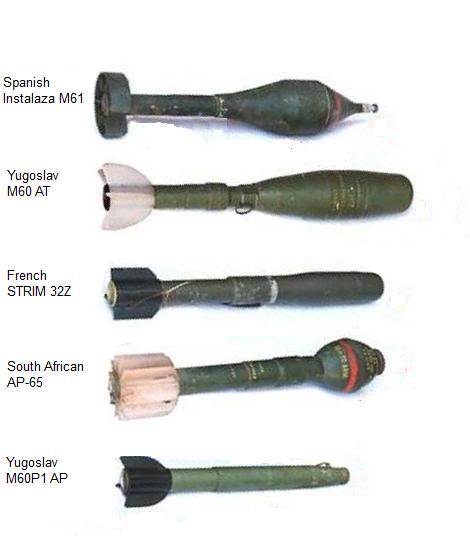|
Strim 40
The STRIM 40 is an anti-personnel rifle grenade of French design and manufacture. In addition to being manufactured in France, it was also made under licence in Belgium by Mecar, with the designation "AP 32 Z", and an enhanced version with the designation "AP 32 ZA". It was propelled by being mounted atop a rifle's 22 mm grenade launching adapter, and being launched by a ballistite (blank) cartridge. In common with other rifle grenades of this era, they became obsolescent when the bullet trap form of propulsion became popular at the end of the 1970s. Production had ceased in France by 1980. Whilst the Belgian army went on to use the new generation of bullet trap grenades, Mecar did continue to manufacture it for export customers into the mid 1980s The Brazilian manufactured M2 anti-personnel and M3 anti-tank rifle grenades bear a strong similarity to the STRIM 40 and STRIM 65 A string trimmer, also known by the portmanteau strimmer and the trademarks Weedwacker, Weed eater ... [...More Info...] [...Related Items...] OR: [Wikipedia] [Google] [Baidu] |
Mecar
Mecar is a Belgian weapon and ammunition manufacturing company headquartered in Petit-Roeulx-lez-Nivelles, Hainaut Province. Mecar is responsible for creating weapons ranging from grenades to lightweight anti-tank cannons. The company was established in 1938 and now produces arms for NATO, Belgium, and other various countries. The company is now a wholly owned subsidiary of NEXTER Systems S.A., a French Defense Systems JSC Defense systems is a Russian-Belarusian air defense Anti-aircraft warfare, counter-air or air defence forces is the battlespace response to aerial warfare, defined by NATO as "all measures designed to nullify or reduce the effectivenes ... company following the acquisition in May 2014. References {{reflist Manufacturing companies established in 1938 Manufacturing companies of Belgium Weapons manufacturing companies Belgian companies established in 1938 ... [...More Info...] [...Related Items...] OR: [Wikipedia] [Google] [Baidu] |
22 Mm Grenade
A 22 mm rifle grenade is inserted over the firing mechanism on the front of rifles that are equipped with the appropriate spigot-type launcher, either in the form of an integral flash suppressor or a detachable adapter. As with most rifle grenades, it is propelled by a blank cartridge inserted into the chamber of the rifle. A 22 mm grenade can range from a powerful anti-tank round to a simple finned tube with a fragmentation hand grenade attached to the end. The "22 mm" refers to the diameter of the base tube which fits over the spigot of the launcher, not the diameter of the warhead section, which is much wider. This measurement practice differs from conventional launched grenades, such as the US 40 mm grenade, which are measured at their widest point, since they are launched out of gun-like barrels. Thus, a 22 mm rifle grenade can easily be as powerful as a 40 mm grenade, in spite of the seemingly smaller size. A 22 mm grenade is launched on the spi ... [...More Info...] [...Related Items...] OR: [Wikipedia] [Google] [Baidu] |
STRIM 65
A string trimmer, also known by the portmanteau strimmer and the trademarks Weedwacker, Weed eater and Whipper Snipper. is a garden tool for cutting grass, small weeds, and groundcover. It uses a whirling monofilament line instead of a blade, which protrudes from a rotating spindle at the end of a long shaft topped by a gasoline engine or electric motor. String trimmers are commonly used for cutting low foliage near obstacles or on steep or irregular terrain. Most professional-grade line trimmers can accept attachment blades to be used as brush cutters for more dense vegetation. History The first brush cutter was produced in Japan in 1960 by Echo. The U.S. string trimmer was invented in the early-1970s by George Ballas of Houston, Texas, who conceived the idea while watching the revolving action of the cleaning brushes in an automatic car wash. His first trimmer was made by attaching pieces of heavy duty fishing line to a tin can bolted to an edger. Ballas developed this i ... [...More Info...] [...Related Items...] OR: [Wikipedia] [Google] [Baidu] |
Instalaza And Other Rifle Grenades
Instalaza SA is a Spanish firm that designs, develops and manufactures equipment and other military material for infantry. The company, founded in 1943, is headquartered in Zaragoza, Aragon, where its production plant is also located. Instalaza's professional experience is widely noted as a supplier of both the Spanish armed forces and countries around the world. Instalaza has had Pedro Morenés Eulate, Secretary of State for Defence between 1996 and 2000, Secretary of State Security from 2000 to 2002, Secretary of State for Science and Technology between 2002 and 2004, and currently Minister of Defense, as representative and consultant. As of 2007, Instalaza SA had 140 employees, a covered plant area of , capital worth more than 5 million Euros, and a revenue of 15 million Euros. Cluster munitions ban The company experienced a crisis in 2008 after the ban on cluster bombs enacted by the Convention on Cluster Munitions. In January 2009, Instalaza still had the MAT-120 cluste ... [...More Info...] [...Related Items...] OR: [Wikipedia] [Google] [Baidu] |
Rifle Grenade
A rifle grenade is a grenade that uses a rifle-based launcher to permit a longer effective range than would be possible if the grenade were thrown by hand. The practice of projecting grenades with rifle-mounted launchers was first widely used during World War I and World War II and continues to the present, with the term "rifle grenade" now encompassing many different types of payloads including high explosive, fragmentation, anti-tank warheads, concussion, smoke, incendiary, and flare missiles. Rifle grenades have largely been supplanted in the infantry fire support role by a combination of grenade launchers (typically affixed to rifles) and disposable anti-armor rockets. History Early use Adaptation of grenades for use in rifles began around the 18th century, when cup-shaped dischargers were fitted to the barrels of flintlock muskets, with the grenades propelled by the force of a blank cartridge. During the early 20th century a Japanese Colonel Amazawa experimented w ... [...More Info...] [...Related Items...] OR: [Wikipedia] [Google] [Baidu] |
Rhodesia
Rhodesia (, ), officially from 1970 the Republic of Rhodesia, was an unrecognised state in Southern Africa from 1965 to 1979, equivalent in territory to modern Zimbabwe. Rhodesia was the ''de facto'' Succession of states, successor state to the Crown colony, British colony of Southern Rhodesia, which had been Self-governing colony, self-governing since achieving responsible government in 1923. A Landlocked country, landlocked nation, Rhodesia was bordered by South Africa to the south, Bechuanaland Protectorate, Bechuanaland (later Botswana) to the southwest, Zambia (formerly Northern Rhodesia) to the northwest, and Mozambique (Portuguese Mozambique, a Portuguese province until 1975) to the east. From 1965 to 1979, Rhodesia was one of two independent states on the African continent governed by a White people in Zimbabwe, white minority of European descent and culture, the other being South Africa. In the late 19th century, the territory north of the South African Republic, Trans ... [...More Info...] [...Related Items...] OR: [Wikipedia] [Google] [Baidu] |
Cold War Weapons Of France
Cold is the presence of low temperature, especially in the atmosphere. In common usage, cold is often a subjective perception. A lower bound to temperature is absolute zero, defined as 0.00K on the Kelvin scale, an absolute thermodynamic temperature scale. This corresponds to on the Celsius scale, on the Fahrenheit scale, and on the Rankine scale. Since temperature relates to the thermal energy held by an object or a sample of matter, which is the kinetic energy of the random motion of the particle constituents of matter, an object will have less thermal energy when it is colder and more when it is hotter. If it were possible to cool a system to absolute zero, all motion of the particles in a sample of matter would cease and they would be at complete rest in the classical sense. The object could be described as having zero thermal energy. Microscopically in the description of quantum mechanics, however, matter still has zero-point energy even at absolute zero, because ... [...More Info...] [...Related Items...] OR: [Wikipedia] [Google] [Baidu] |
Rifle Grenades
A rifle grenade is a grenade that uses a rifle-based launcher to permit a longer effective range than would be possible if the grenade were thrown by hand. The practice of projecting grenades with rifle-mounted launchers was first widely used during World War I and World War II and continues to the present, with the term "rifle grenade" now encompassing many different types of payloads including high explosive, fragmentation, anti-tank warheads, concussion, smoke, incendiary, and flare missiles. Rifle grenades have largely been supplanted in the infantry fire support role by a combination of grenade launchers (typically affixed to rifles) and disposable anti-armor rockets. History Early use Adaptation of grenades for use in rifles began around the 18th century, when cup-shaped dischargers were fitted to the barrels of flintlock muskets, with the grenades propelled by the force of a blank cartridge. During the early 20th century a Japanese Colonel Amazawa experimented w ... [...More Info...] [...Related Items...] OR: [Wikipedia] [Google] [Baidu] |





